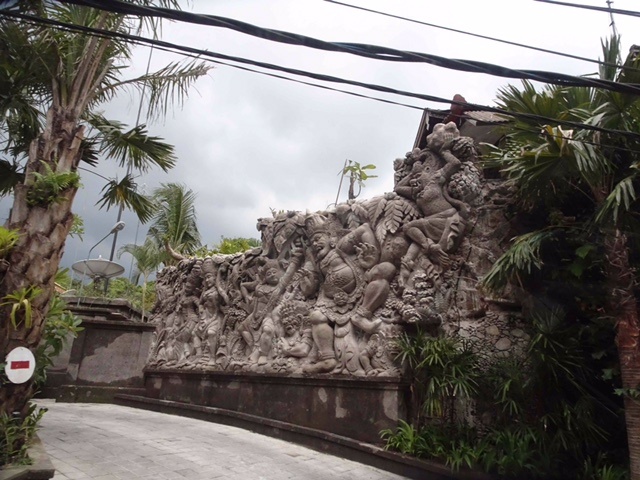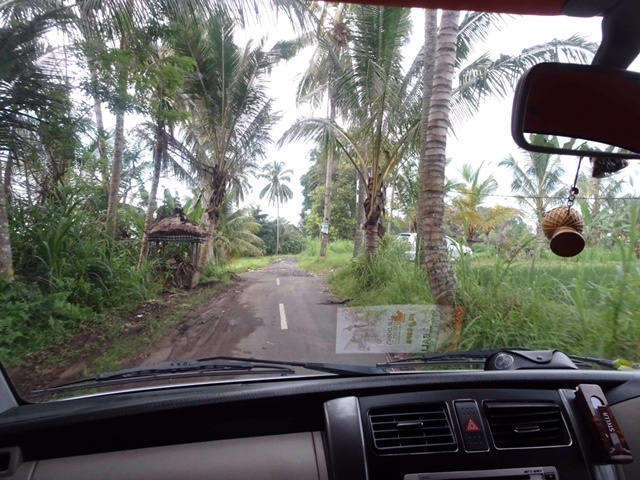
OK, sometimes we have a story that amuses which is accompanied by a slew of great photos. I really wish that today was such a day, but we wisely listened to the advice of our rafting guide and put our camera in a water-proof bag.
“But Steve”, I hear you say, “That is only logical. White water rafting and electronics to not mix.”
In retrospect, this seems massively obvious, but please let me explain why I was not so sure when we went on the trip.
Susie booked the rafting trip partially as a fun way to transition from the beach villa to Ubud, the spiritual center of Bali (and the city featured in “Eat, Pray, Love”). They agreed to pick us up at our first hotel and deliver us to the second.
Looking at the website with US eyes, we were certain that we were on our way to a pedestrian experience. While talking about “white water rafting”, the description was deceptive in two critical ways – one an act of commission and one of omission.
The act of commission came from the website. It talked in great length about the “stunning scenery” and the “lovely jungle” with “views of the canyon”. There was no mention of adventure, excitement or thrills. We read this and concluded that this would be like floating the Comal River next to New Braunfels in an innertube – pleasant, but slightly boring.
The second clue (the error of omission) was the lack of any warning whatsoever. In the US, a concern for litigation leads to warnings on everything. You cannot buy a snow ski, a water ski or even a kneeboard without reading a litany of warnings that itemize all the ways you can be injured or even killed. Every amusement park ride (short of the slowest available) will remind “people with bad backs and pregnant women” to avoid the ride. As camp owners, we must create a document that itemizes a vast array of potential risks that could (but likely will not) ever happen. That is something we are accustomed to.
When you do NOT see such a warning, you assume you are on your way to a sedate and simple experience.
Well, my friends, Bali runs by a different set of rules. It reminds me of an experience Susie and I had in 2003 in New Zealand. We participated in the “Black Water Rafting Excursion” in Waitomo (North Island). This experience would involve no warnings and no release form. But within 5 minutes of the experience, we would get a 5 minute briefing on abseiling (a type of rappelling) and would then be lowered 200 feet straight down a hole in the ground. We did get some advice.
“If you accidentally let go of your rope (yes, we were lowering ourselves), you must yell loudly. If we hear you yell, we can pull the safety line and stop your fall. Otherwise, you will bounce.”
Yes, “you will bounce” were the words from our intrepid guide.
Over the next two hours, we would jump blindly (it was pitch black in the cave) 15 feet into frigid water with an innertube, go through caves with water so high that we would often have to hold their breath for 10-15 seconds and eventually climb through a waterfall. [Note: all the previous adventures came with typical Kiwi calm – everything is easy and OK. When we got to the waterfall, our staggeringly mellow New Zealander suddenly became VERY focused on where we would put our feet to climb up the 12 foot torrential waterfall. We could only guess that this part of the adventure often went very poorly.]
As we left, I was amazed. We particulated in at least 5 activities that would have had massive warnings in the US. In fact, at least one of them would not have even been offered in the states.
Yet we went through the whole experience with nothing more than a “lets have a great time , mate!”. No warnings and no releases.
Amazed by this, I asked the head guide why we did not need to sign releases.
“Because we have this concept in New Zealand, mate,” he smiled, “It’s called an ‘accident’”.
Well, Bali is more like New Zealand than Disneyland.
At the last minute, I decided to put my phone and my camera in the waterproof bag that our guide offered me. I felt a little like a wimp. I expected that we would float happily for 2 hours and I would miss photos of the beautiful scenery with my camera.
We made the right decision. We had class 2 and 3 rapids. We all emerged completely soaked. During the briefing, our guide trained us in “boom, boom”.
“Boom, boom” was perhaps the only command that we always understood. It meant “get your entire body inside the raft as low as you possibly can so that you will not fall out of the raft.”
When our man said “boom, boom”, the gentleman MEANT “boom, boom”.
We would get this order 8 times. We would go over 1 waterfall and navigate multiple serious rapids. At one point, we stopped at a waterfall next to the river and were challenged to walk under it. Happily, we were wearing helmets. The water hit like rocks.
It was a blast, but we have little visual evidence for your enjoyment.
I have only a few photos. The one at the start of the blog is the waterfall (and the crowd that joined us). We pulled my camera out of the dry-bag for this one.
The second is a carving next to a hotel. I share this because the rafting trip had the oddest little addition. For about 100 feet, a huge section of the rock wall was carved into a mythological scene, the Balinese Romeo and Juliet. It looked like something in an amusement park, but there it was. I, however, was soaked and my camera in the dry bag, so I could not take that shot. This is a proxy.

Third, we have learned that the swastika was originally an Indian symbol meaning "well being". Clearly, no image has ever deviated from its initally meaning as radically as this one. It is quite an odd experience to go to a religious site and see this symbol.

Fourth, to get to the rafts, we had to go down 400-500 steps that were (as Moak Sir might say) "not to code" - averaging 12-15 inches (rather than 8). It was not great on the knees.

Finally, substandard roads continue to be part of our lives. I know this looks like a golf cart (please compare the size of the car to the road), but it is designed for two lanes of traffic. I think they believe that if you paint a line down the middle, you have a two-laned road – even if it is only 1.25 cars wide. Exciting!

Steve Sir


